Estimated reading time: 11 minutes
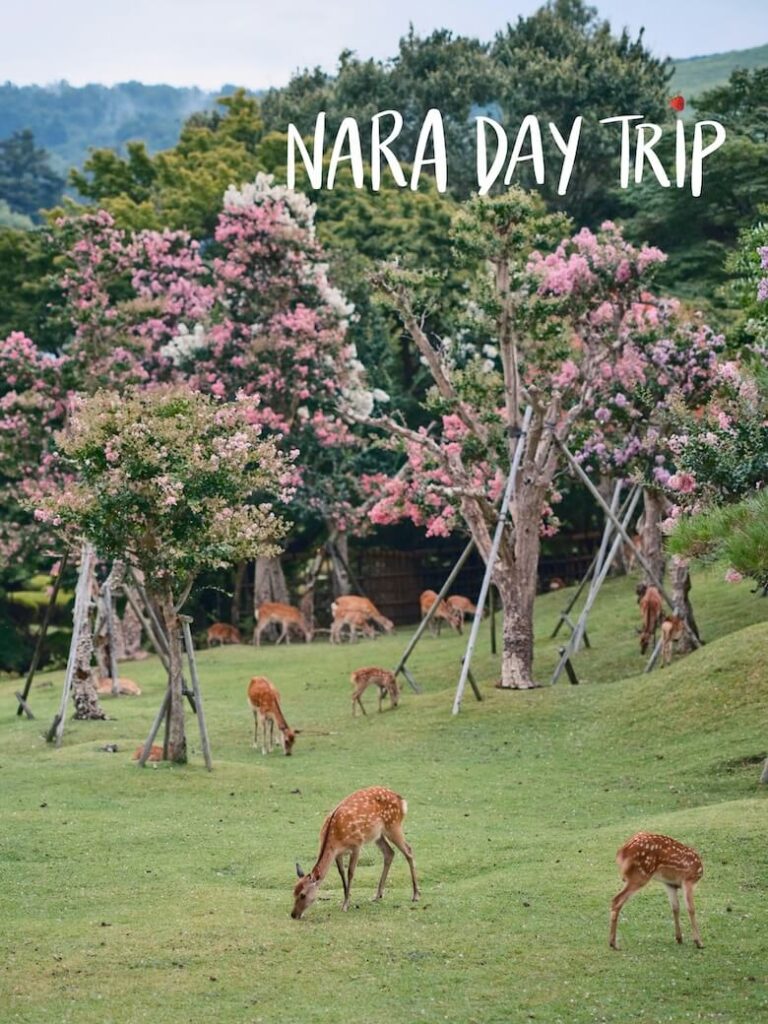
Nara is an unmissable city for your first trip to Japan! This small town is famous for its wild animals, peaceful temple grounds, and Shinto shrines. It is one of the most popular day trip you can take in the Kansai region, and is definitely worth visiting.
For an enjoyable full day in this beautiful town, it is best to plan in advance according to your interests! Read on to create the best Nara itinerary for you and your travel companions. 🦌
- Check out my video on Nara! 🦌
- Getting to Nara
- From Osaka
- From Kyoto
- Getting Around Nara
- Best Things To Do in the City
- 1. Feeding the Bowing Deer in Nara Park
- 2. View the Giant Buddha at Todai-ji Temple
- 3. Tea Time at Salon Naramachi
- 4. Visit the Higashimuki Shopping Street (Famous Mochi Pounding Show!)
- 5. Feeding Koi Fish at Manyo Botanical Garden
- 6. Stone Lanterns at Kasuga Taisha Shrine
- 7. Isuien Garden
- Nara Day Trip Itinerary
Check out my video on Nara! 🦌
Getting to Nara
Thank god for Google Maps in Japan! Navigating trains has not been this easy; Google Maps in Japan even has suggested car number you can take to minimize walking during transfers. Let me give you an overview of routes from Osaka to Nara and Kyoto to Nara.
Did you know?
Nara used to be the capital of Japan from 710-784!
From Osaka
With an IC card (Suica, Icoca, Pasmo)
From the Osaka-Namba Station, you can take the Kintetsu Nara line. This train route goes straight to Kintetsu Nara Station, and it takes around 37 minutes and 8 stops to reach this train station. During my trip, this train route cost ¥680 (Express) or 1200-1300 (Limited Express). This route is not covered by the JR Pass.
There are three types of train you can take on the Kintetsu-Nara line: Express, Rapid Express, and Local. The difference between the three is the number of stops they are making. Local trains stop at all stations (cheaper, but it takes longer!), while Rapid Express trains stops at less stations. The Express train, on the other hand, stops at even less station than Rapid- only at notable ones. To get to Nara, you can take all three types from Osaka-Namba Station!
The Kintetsu Nara Station is only a short walk away from Nara Park, 6 minutes of walking.
With a JR Rail Pass
If you have a JR Pass, you can take the JR Yamatoji line from JR Namba Station. This trip duration is around 46 minutes, costing ¥580. With the Japan Rail Pass, the train ticket cost should be covered.
You will arrive at the JR Nara Station, and it is further away from Nara Park. It is 20 minutes on foot, compared to the 6 minute walk of walking from Kintetsu Nara Station.
From Kyoto
With an IC card (Suica, Icoca, Pasmo)
If you are starting your trip in Kyoto Station, you can take the Kintetsu-Kyoto Line or the Karasuma Line. They are both direct trains to Kintetsu-Nara Station, taking around 46 minutes. The Kintetsu train costs ¥760 (Direct Express), while the Karasuma Line costs ¥1,020.
With a JR Rail Pass
For JR Pass holders, take the Miyakoji JR line from the Kyoto Station. This line operates every 30 minutes, and is covered by the Japan Rail Pass. The trip duration is around 45 minutes and costs ¥720.
Getting Around Nara
The main attractions around Nara can be reached on foot! If you are arriving at the JR Nara Station, stop by the Tourist Information Center nearby for informational booklets on this peacefully zen city. If you start your trip from the Kintetsu-Nara Station, though, go straight to the attractions as it’s so much closer from this train station!
Nara was the first permanent capital of Japan, and the main sights to see here are Nara Park, ancient temples,
A few things to pay attention to:
- Be careful about bringing wheeled luggages in Nara. The grounds where deer roam is covered in, you guessed it, deer poop! Consider using luggage storage lockers, which are available in both Kintetsu Nara Station and JR Nara Station.
- Pay attention to time, as most things in Nara will close at around 5 PM
- Prepare some cash on hand, because some admission tickets are cash only
Best Things To Do in the City
If you are planning your Nara Day trip itinerary, these are the must-see sights in town!
1. Feeding the Bowing Deer in Nara Park
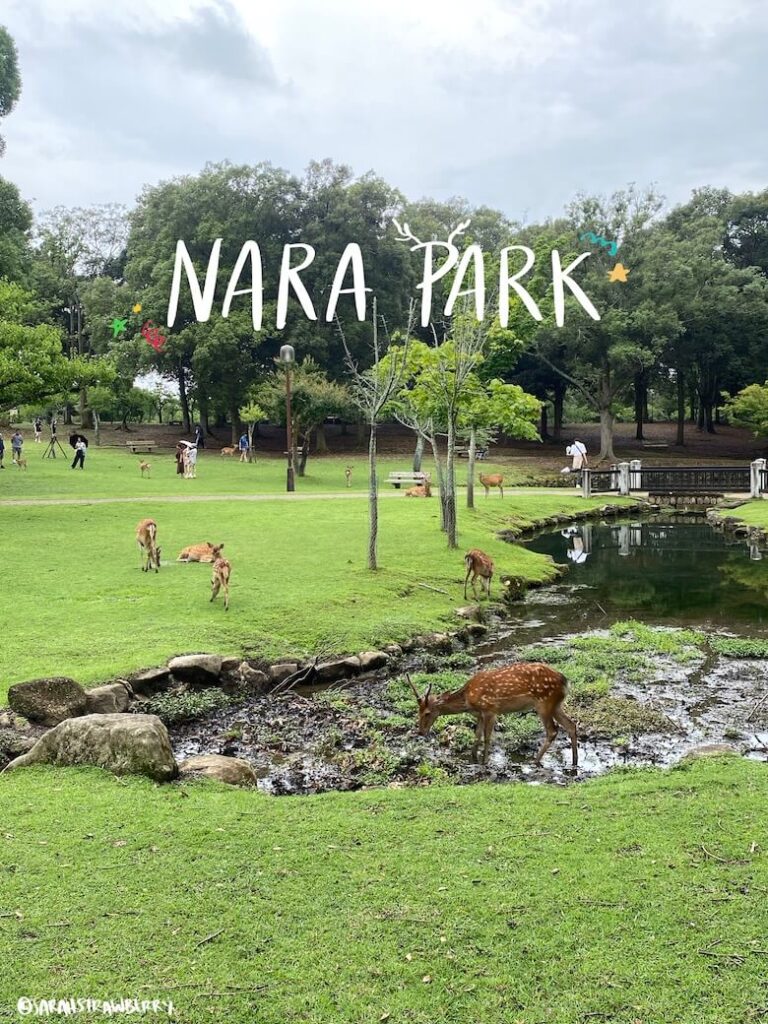

This is the most sought after activity in Nara, and a must-do for first time visitors! Locals have protected wild deer for over 1,000 years, and they roam free in this town.
The origin story of this is that the main deity of Kasuga Taisha Shrine, Takemikazuchi, uses deer as messenger. The thunder god first appeared in Nara riding a white deer. Back then, killing this holy animal was punishable by death!
Now, though not considered sacred anymore, around 1,400 wild deer walk around the grounds. These free-roaming deer will bow if you feed them, a delightful trick that amuses many visitors. The enthusiasm of bowing, I believe, depends on how hungry they are 😂
Do not forget to get some deer crackers beforehand! These specialty deer biscuits are the only thing tourists are allowed to hand out. They are made out of wheat flour and rice bran (no sugar allowed!).
You might get overwhelmed with the crowd at Kofuku-ji Temple grounds, but walk further into the Nara Park and you will find a vast expanse of soothing green space.
Deeper inside the park, you can feed and interact with the herds of deer with more breathing room. It makes for better photos as well!
Fun fact! ✨
These special crackers are called shika senbei in Japanese, from the shika deer found here!
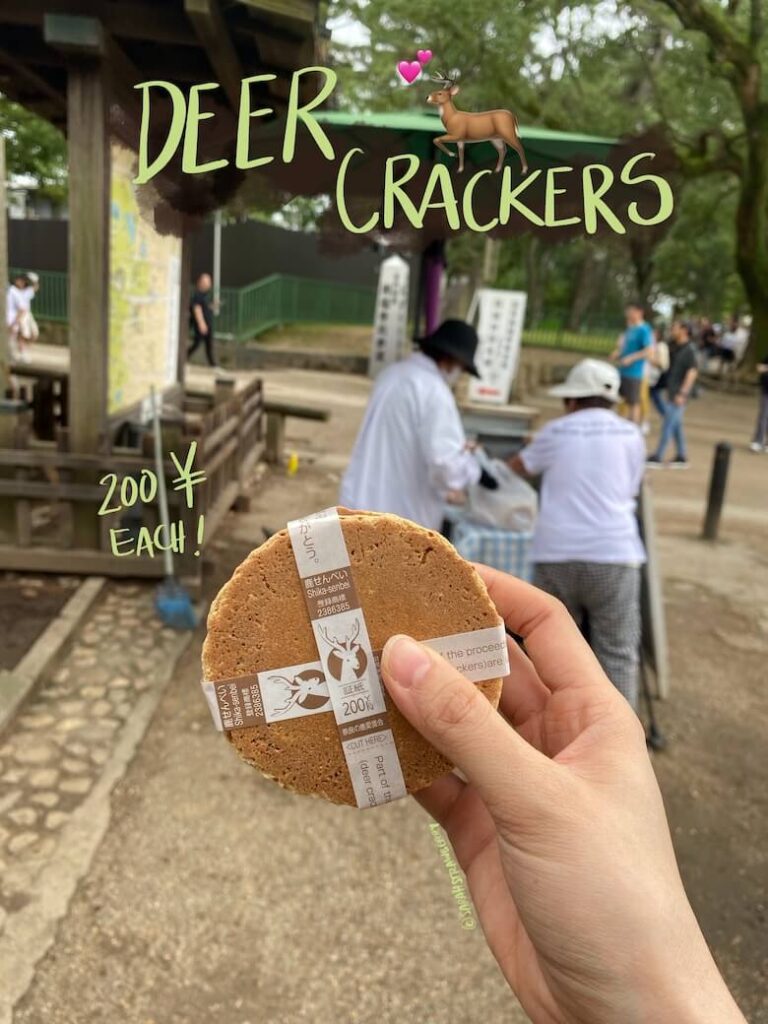
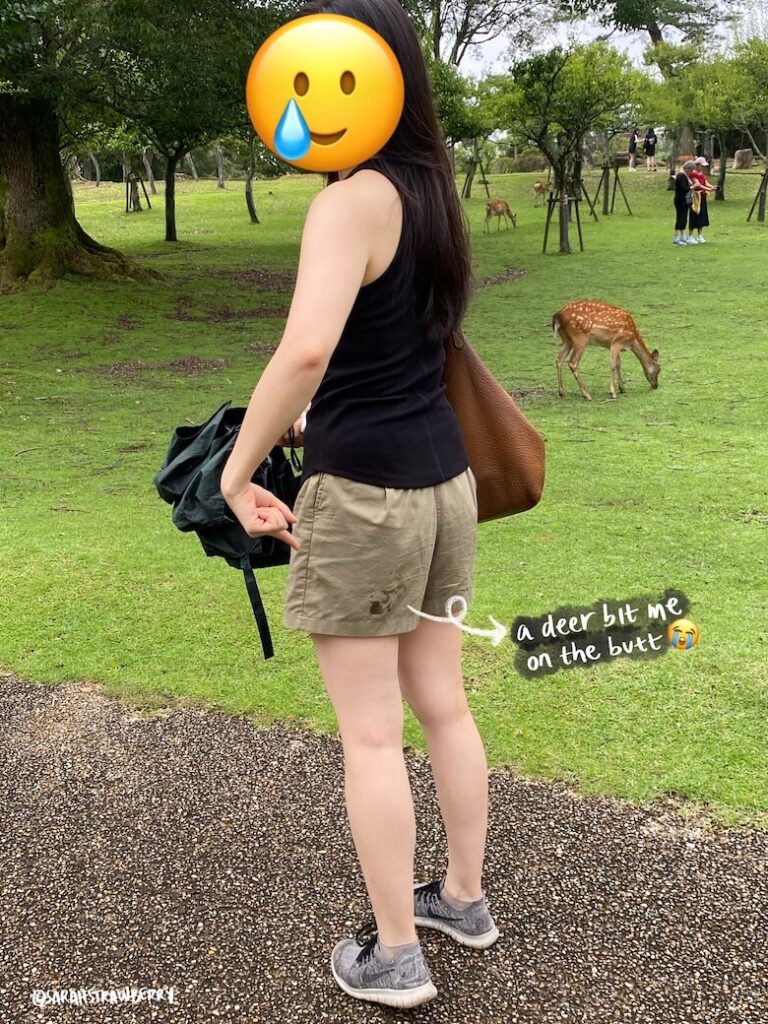
The shika deer can get aggressive when they are hungry (and eyeing your crackers!). They DO bite and poke with their antlers to ask for crackers, as I unfortunately experienced it firsthand.
2. View the Giant Buddha at Todai-ji Temple
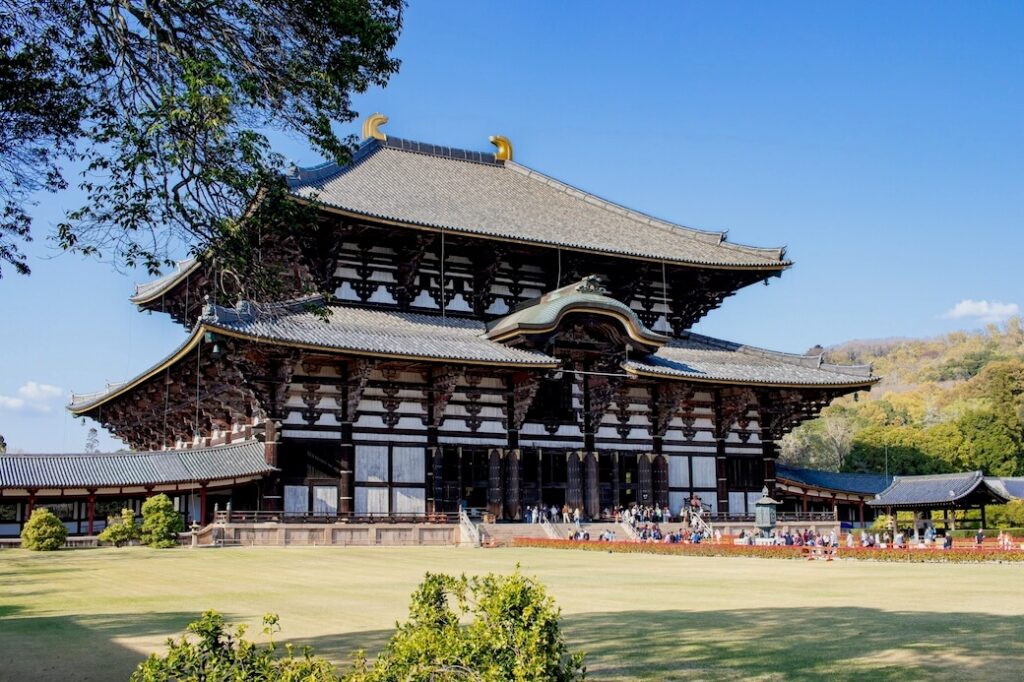
The iconic Tōdai-ji Temple is listed as one of UNESCO world heritage sites! This Buddhist temple is the most famous site in Nara.
Its main attraction is the world’s largest bronze Buddha statue located in the Great Buddha Hall. Todai-ji Temple is also the world’s largest wooden structure- I couldn’t imagine the sheer size of it until I visited.
This magnificent temple had been destroyed twice by fire, and the current building was rebuilt in the Edo period. The Great Buddha Hall is also the main hall. The bronze Buddha statue (Daibutsu) inside weighs 500 tons!
The adult admission ticket costs ¥800 per person, and for children 12 years old or below it is ¥400.
3. Tea Time at Salon Naramachi
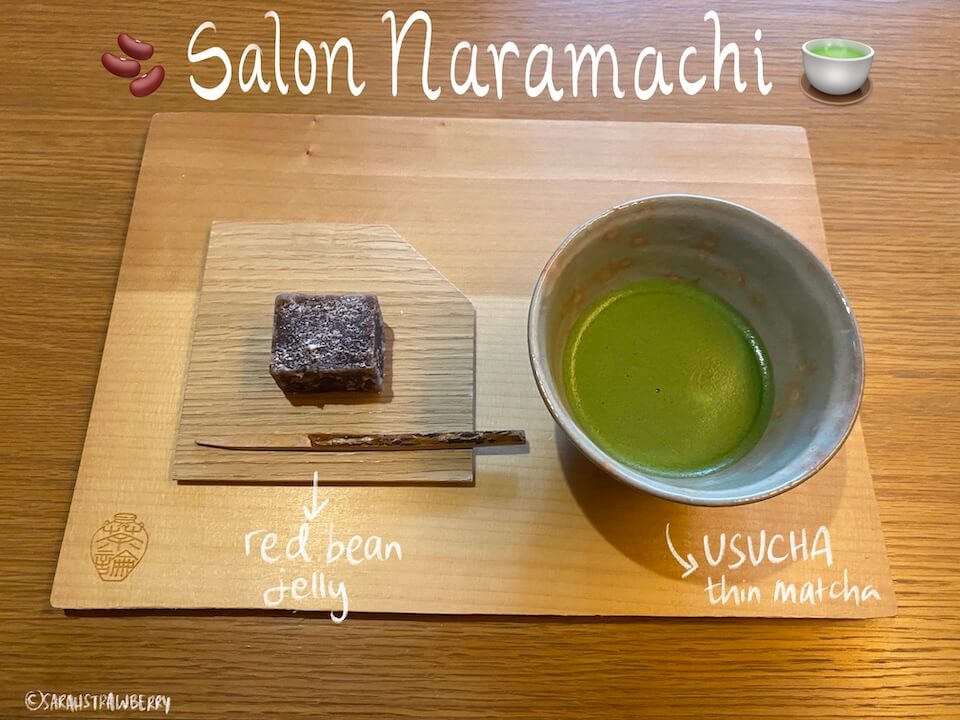
If you are looking for a peaceful time tea time after visiting crowded sites, Salon Naramachi is the answer. The zen tea salon has sets with matcha and wagashi, traditional tea and snacks unique to Japan. We were shown to a private tatami room next to the peaceful garden situated in the middle of the premises.
You can pick the matcha concentration you want with its basic set. My choice was the thin whisked matcha usucha and red bean jelly, yokan. The subtle sweetness of the jelly perfectly complements the grassy bitterness of the green tea. Take your time to relax and breathe in the tranquil environment.
Bonus: The store in the same building sells super cute embroidered handkerchiefs as souvenir! They can custom-make it with your initials as well, what a special gift.
4. Visit the Higashimuki Shopping Street (Famous Mochi Pounding Show!)
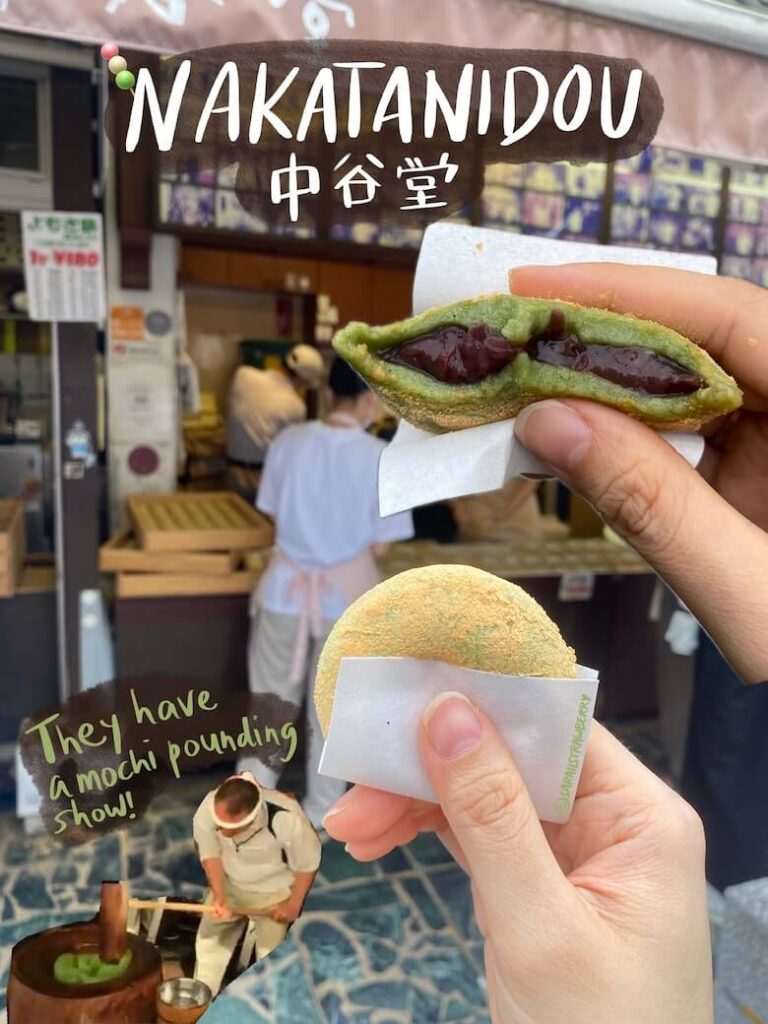
I’m guessing you have probably seen this clip of two guys hammering down mochi somewhere on the internet. The shop is in Nara! The owner apparently brought over this high-speed pounding technique from his hometown, Kamikitayama Village. They don’t have a set schedule for this mochi pounding show, but it is one unmissable (high-energy!) sight everyone wants to see when they visit.
The mochi shop’s name is Nakatanidou, and it is located nearby the Higashimuki Shopping Street. I had the pleasure of tasting these mugwort mochi with red bean filling, and the softness of the yomogi mochi is like no other! The exterior is dusted with roasted soybean flour (kinako), which adds a delightfully nutty flavor to this treat. Each yomogi mochi costs ¥150.
The covered Higashimuki Shopping Street is a nice place to shelter from the rain and heat. Find souvenirs, local food, and chain restaurants at this market.
5. Feeding Koi Fish at Manyo Botanical Garden
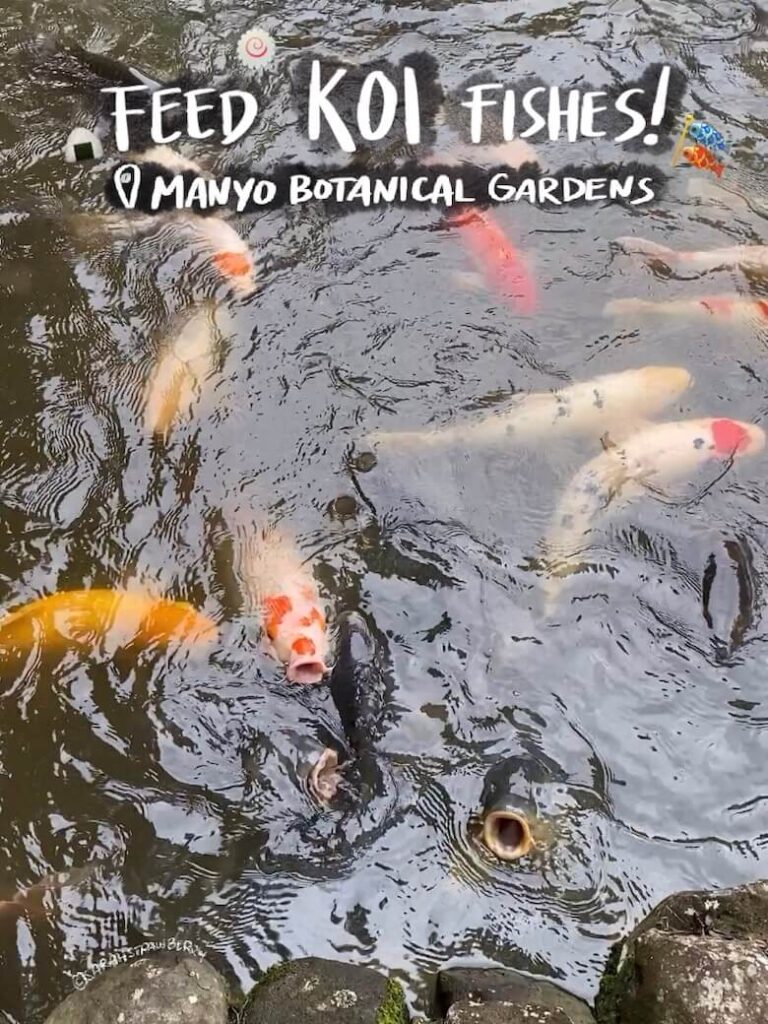
When you stroll further along into the Nara Park, you will find the Manyo Botanical Garden. It has 300 different kinds of plants and flowers, which were described in Japan’s oldest collection of poems called Manyoshu. Do check the flowering times to make sure when they bloom! One of the must-see sights in May is the swaying purple wisteria flowers in the garden.
There is a large koi pond as well, where they provide fish food for you to feed them with. These fishes are huge, and I’m sure it’d be especially fun for children!
The botanical garden has a ¥500 admission fee.
6. Stone Lanterns at Kasuga Taisha Shrine
Kasuga Taisha Shrine is a Shinto shrine built in the 8th century, also a UNESCO world heritage site. It is known for the 3,000 bronze and stone lanterns which were donated by worshippers. You can visit the outer area for free, but you need to pay the admission fee of ¥500 to explore the inner area. Check out their official website for opening times, since they can differ by month.
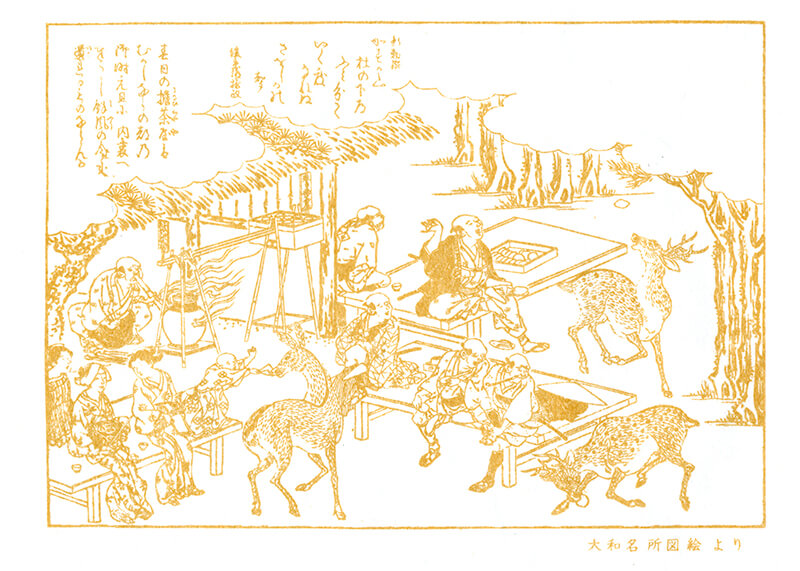
The garden café, “Ninai Jaya“, has been serving tea and sweet rice cakes on the shrine grounds since the mid-18th century.
7. Isuien Garden
The name Isuien (依水園) means “garden founded on water”, a nod to the nearby Yoshiki River. This traditional Japanese garden is calm, pristine, and relaxing compared to the busy Nara Park and nearby temples. It has a teahouse where you can enjoy tea and traditional sweets while enjoying the beautiful scenery. The Isuien Garden has volunteer tour guides who will give you a tour of the place. The admission ticket costs ¥1200.
Nara Day Trip Itinerary
For a day trip, I personally think a half-day is enough to see the highlights of Nara. A typical route would be as following:
- Arrive at Kintetsu-Nara Station
- Walk down the Noboriojicho (Nobori-oji street) to the Kofuku-ji National Treasure Hall
- See and interact with the bowing deer in the Kofuku-ji area
- Stroll to Todai-ji Temple to view the largest Buddha statue (Daibutsu) in the Great Buddha Hall
- Feed the bowing deer at the beautiful Nara Park
- Walk along to the Kasuga Taisha Shrine, optional visit to the Manyo Botanical Garden to feed koi fishes
- Head to Salon Naramachi for a relaxing tea time accompanied by traditional wagashi snacks
- View mochi pounding show at Nakatanidou and the Higashimuki Shopping Street
- Head back to Osaka/Kyoto by train
In summary, Nara is such a wonderful place for a day trip! Take a day or two out of your Kyoto or Osaka trip, and say hello to the bowing deer in this city with rich history.
P.S. = Curious about “I’m donut ?”, the mega viral donut in Tokyo?
Pin it for later!


3 comments on “Fun Nara Day Trip Itinerary (Best Things to Do!)”